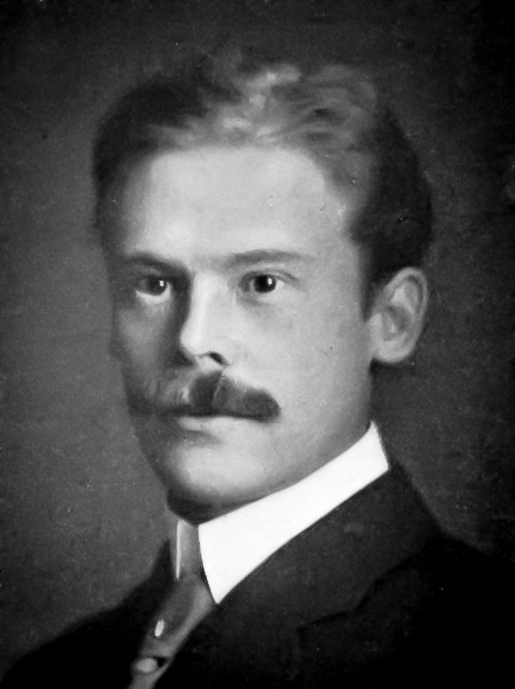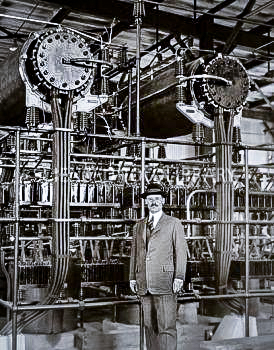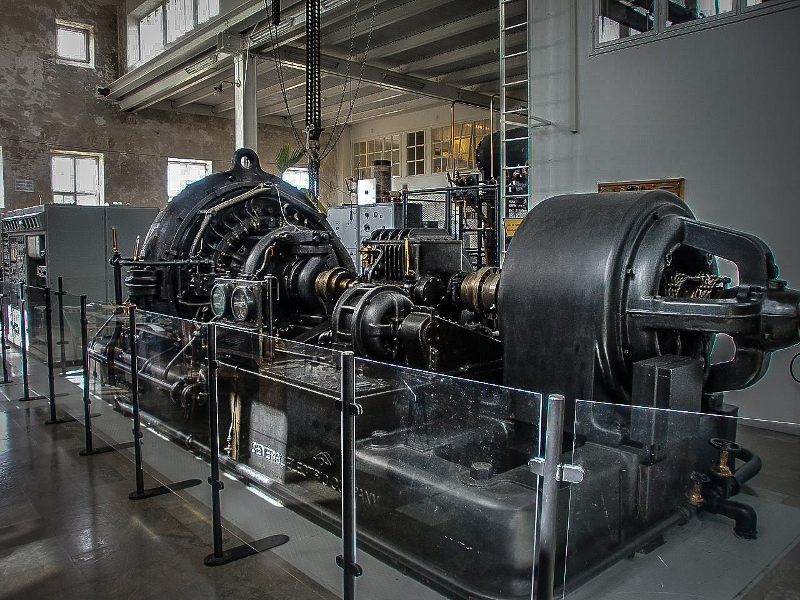May 14, 1975) was a Swedish-American electrical engineer, who was a pioneer in radio and television development. He invented the Alexanderson alternator, an early radio transmitter used between 1906 and the 1930s for longwave long distance radio transmission. Alexanderson also created the amplidyne, a direct current amplifier used during the Second World War for controlling anti-aircraft guns.
Alexanderson designed the Alexanderson alternator, an early longwave radio transmitter, one of the first devices which could transmit modulated audio (sound) over radio waves. He had been employed at General Electric for only a short time when GE received an order from Canadian-born professor and researcher Reginald Fessenden, then working for the US Weather Bureau, for a specialized alternator with much higher frequency than others in existence at that time, for use as a radio transmitter. Fessenden had been working on the problem of transmitting sound by radio waves, and had concluded that a new type of radio transmitter was needed, a continuous wave transmitter. Designing a machine that would rotate fast enough to produce radio waves proved a formidable challenge. Alexanderson's family were convinced the huge spinning rotors would fly apart and kill him, and he set up a sandbagged bunker from which to test them. In the summer of 1906 Mr. Alexanderson's first effort, a 50 kHz alternator, was installed in Fessenden's radio station in Brant Rock, Massachusetts. By fall its output had been improved to 500 watts and 75 kHz. On Christmas Eve, 1906, Fessenden made an experimental broadcast of Christmas music, including him playing the violin, that was heard by Navy ships and shore stations down the East Coast as far as Arlington. This is considered the first AM radio entertainment broadcast.
Alexanderson continued improving his machine, and the Alexanderson alternator became widely used in high power very low frequency commercial and Naval wireless stations to transmit radiotelegraphy traffic at intercontinental distances, until by the 1930s it was replaced by vacuum tube transmitters. The only surviving transmitter in a working state is at the Grimeton radio station outside Varberg, Sweden. It is a prime example of pre-electronic radio technology and was added to UNESCO's World heritage list in 2004.
Alexanderson was also instrumental in the development of television. The first television broadcast in the United States took place during 1927 at his GE Plot home at 1132 Adams Rd, Schenectady, N.Y.
Alexanderson retired from General Electric in 1948. The inventor and engineer remained active to an advanced age. He continued television research as a consultant for the Radio Corporation of America filing his 321st patent application in 1955. Over his lifetime, Alexanderson received 345 US patents, the last filed in 1968 at age 89. He died in 1975 and was buried at Vale Cemetery in Schenectady, New York.
Alexanderson is also mentioned in connection with the emergence of the patent system, that he was partially critical to. As the technology historian David Noble writes:
"The change in the focus of the patent system, from the protection of the inventor to the protection of the corporation which either employed the inventor or purchased his patents, was succinctly phrased by E.F.W. Alexanderson, a Swedish immigrant who became one of GE's early leading research engineers. 'The patent system was established, I believe', he said, 'to protect the lone inventor. In this it has not succeeded... the patent system protects the institutions which favor invention'"
 Return to Radio Pictures
Return to Radio Pictures
 Return to MCRN Home
Return to MCRN Home
 Ernst Frederick Werner Alexanderson (January 25, 1878 ➙ May 14, 1975) was a Swedish-American electrical engineer, who was a pioneer in radio and television development. He invented the Alexanderson alternator, an early radio transmitter used between 1906 and the 1930s for longwave long distance radio transmission. Alexanderson also created the amplidyne, a direct current amplifier used during the Second World War for controlling anti-aircraft guns.
Ernst Frederick Werner Alexanderson (January 25, 1878 ➙ May 14, 1975) was a Swedish-American electrical engineer, who was a pioneer in radio and television development. He invented the Alexanderson alternator, an early radio transmitter used between 1906 and the 1930s for longwave long distance radio transmission. Alexanderson also created the amplidyne, a direct current amplifier used during the Second World War for controlling anti-aircraft guns.



![]() Return to Radio Pictures
Return to Radio Pictures
![]() Return to MCRN Home
Return to MCRN Home